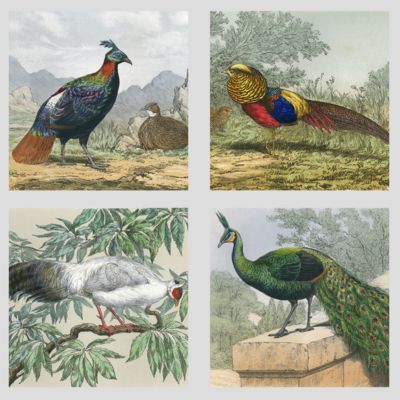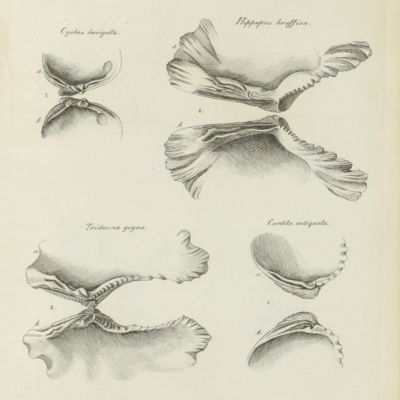Utterly rare and perhaps the most complete copy known
Deyrolle, T.
Illustrations zoologiques.
Published
1874
Item ID
75800
Sorry, this item is currently not for sale. Please contact us for more information.
Paris, E. Deyrolle, 1874. Oblong folio (26.8 x 36.8 cm). 50 chromolithographed ("chromographie") plates, finished by hand. Contemporary green morocco over green marbled boards. Spine with five raised, gilt-lined bands and title. Marbled endpapers.
A magnificent ornithological and mammalogical atlas, with beautiful illustrations by the French artist Théophile Louis Deyrolle (1844-1923) - mainly known as a genre and landscape painter, which shows here, and published by his elder brother, the taxidermist and natural history dealer Émile Gustave Achille Deyrolle (1838-1917). The first 48 plates, except five, are dated ( janvier to décembre 1874). This includes a large suite of 40 numbered pheasant plates (numbered I-XVIII, XXIII, XXIII[bis], XXV, XXV[bis], XXVII-XXIX, XXXI-XXXIV, XXXVI-XXXIX, XXXIX[bis], XL-XLV). The second XXIII, and XXV could be errors for XXIV and XXVI, but this leaves the double use of XXXIX, as well as the absence of XIX-XXII, XXX, and XXXV unexplained. Plates with these numbers are entirely unknown. The other ten plates show poultry, dogs, and a few wild mammals, as Rongeurs I, Antilopes I, Chiens I-II, Lapins I, and Coqs et Poules I-V. In the rear, six more plates are bound in, all showing parrots, and numbered I-VI. They are not dated and differ in being not in "landscape" but in "portrait" format. These plates were painted and engraved by the German natural history artist Gustav Ludwig Heinrich Mützel (1839-1893) for Anton Reichenow's Vogelbilder aus fernen Zonen, published by Theodor Fischer in Kassel (1878-1883). Evidently a former owner decided to combine work of Deyrolle and Mützel in one volume. We did not count these extra plates in our total. According to Ronsil, "Avec les Illustrations zoologiques de Th. Deyrolle, la photochromie fait son apparition dans l'iconographie ornithologique. Ces photochromies représentent des 'figures d'animaux utiles ou pouvant être acclimatés en Europe'. Nous y trouvons une quarantaine de bonnes planches de Faisans, édités à l'usage des aviculteurs. Ces beaux Oiseaux étaient dessinés et lithographiés par Th. Deyrolle d'après les exemplaires vivant au Jardin d'Acclimatation du Bois de Boulonge. Presque toutes ces figures sont retouchées à la main". Ronsil's description thus does not mention the mammalian plates. In his earlier Bibliographie Ornithologique Française, Ronsil, under " Illustrations zoologiques" (no author mentioned), records: "Figures d’animaux utiles ou pouvant etre acclimatés en Europe. 44 (?) planches de Phasanidés numerotées I - XLIV (?) Quelques autres planches color de coqs et poules sauvages ont paru également." In any event, these Deyrolle plates must be utterly rare, as apart from Ronsil's copy, and an incomplete copy (just 20 plates) in the British Museum, this is the only copy known to exist. In fact, Ronsil may not have seen it at all, as he did not observe the gaps in plate numbering, and the double use of several numbers. Moreover, he missed the last pheasant plate (XLV), and several of the other plates. Provenance: armorial bookplate "Cave muscam pungit" of the library of Pierre Mouchon, an important collector and writer of books on hunting, mounted on the front pastedown.
read more
The letters "L.V." on the spine foot may refer to another former owner, most probably the French physician and explorer, Louis Auguste André Marie Vaillant (1876-1963). He was a son of the French zoologist Léon Louis Vaillant (1834-1914). Ronsil, Bibliographie, 1435 (inaccurate); Ronsil (1957). l'Art français dans le livre d'oiseaux states pp. 89-90. Not in any other major reference work, such as Anker, Nissen IVB, Sitwell, and Zimmer. OCLC only records one, manifestly incomplete copy.
read less





